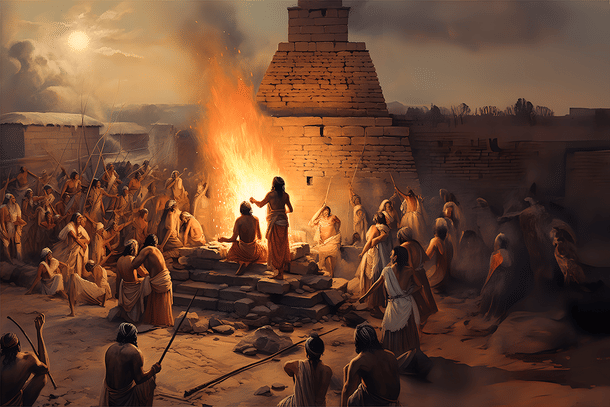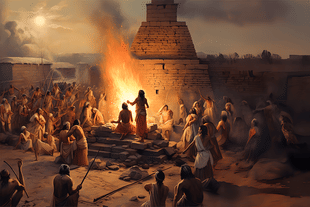Culture
'Indo-European' - Beyond The Homeland Question
Aravindan Neelakandan
Aug 07, 2023, 02:08 PM | Updated 02:12 PM IST
Save & read from anywhere!
Bookmark stories for easy access on any device or the Swarajya app.


Twenty years ago, in 2003, a study in Nature that analysed ‘a matrix of 87 languages with 2,449 lexical items’ came to the conclusion that the Indo-European languages ‘expanded with the spread of agriculture from Anatolia around 8,000–9,500 years Before Present (BP)’.
The study used the model to evaluate two dominant hypotheses – Steppe expansion through horse riding pastoralists and Anatolia expansion through farming.
The results favoured the latter.
Kurgan expansion is the famous Steppe expansion hypothesis which in many ways can morph into a typical ‘Aryan Invasion/migration model’ that Indians are familiar with.
At the same time, the study also told this:
The consensus tree also shows evidence of a period of rapid divergence giving rise to the Italic, Celtic, Balto-Slavic and perhaps Indo-Iranian families that is intriguingly close to the time suggested for a possible Kurgan expansion.Gray RD, Atkinson QD (2003) Language-tree divergence times support the Anatolian theory of Indo-European origin. Nature 426(6965):435–439
Then, in 2015, another paper through ‘a phylogenetic analysis in which ancestry constraints permit more accurate inference of rates of change’ claimed ‘that the result strongly supports the steppe hypothesis.’
Inside the paper, although, one found interesting data.
The model had assumed the age of Vedic Sanskrit as 1500-1000 BCE which corresponds to 3250 BP. (Chang et al , Ancestry-constrained phylogenetic analysis supports the Indo-European steppe hypothesis, Language 91(1), 2015,pp-194–244)
The same year another paper in Nature concluded a ‘massive migration from the steppe’ as ‘the source of Indo-European languages in Europe.’ (Haak, W., Lazaridis, I., Patterson, N. et al. Massive migration from the steppe was a source for Indo-European languages in Europe, Nature , 207–211, 2015)
In 2018, another paper published in Royal Society Open Science, based on ‘a Bayesian phylogenetic study of the Dravidian language family’ calculated ‘a median root age for the Dravidian language family’ as around 4000–4500 years BP' while not excluding ‘the possibility that the root of the Dravidian language family is 6000 or 6500 years old.’ (Vishnupriya Kolipakam et al, A Bayesian phylogenetic study of the Dravidian language family, 2018: https://doi.org/10.1098/rsos.171504)
In 2019 a paper by an international team was published in Science.
Titled ‘The formation of human populations in South and Central Asia’, the paper also supported Steppe pastoralists expansion as the vehicle for bringing Indo-European languages into South Asia (larger Indian landmass).
Based on ‘the genome-wide ancient DNA data from 523 individuals spanning the last 8000 years, mostly from Central Asia and northernmost South Asia’, the study concluded that the ‘Steppe ancestry in modern South Asians was primarily from males and disproportionately high in Brahmin and Bhumihar groups’ and that this provided ‘an independent line of evidence for a Steppe origin for South Asia’s Indo-European languages.’ (Vagheesh M. Narasimhan et al, Science, September 2019)
It is in this context that one has to study the paper ‘Language trees with sampled ancestors support a hybrid model for the origin of Indo-European languages’ (Paul Heggarty et al, Science, 28 July 2023).
After identifying the ‘flaws and inconsistencies’ in the previous datasets used, the team created ‘an entirely new database of Indo-European cognate relationships, named IE-CoR’.
Coded by more than 80 specialists of IE languages, the IE-CoR covers 161 languages of which 109 are modern IR languages and 52 are 'time-calibrated historical Indo-European languages'. This robust database has been then subjected to Baynesian phylogenetic analysis.
The results have elements that are quite crucial to ancient Indian history.
The study posits 'south of the Caucasus' as the origin-spot based on the available ancient DNA evidence. It however rejects the Steppes as the origin.
The study favours, as its title says, a hybrid model between Anatolian farming spread and Steppe horse-backed pastoralist expansion because their ‘results are not entirely consistent with either the Steppe hypothesis or the farming hypothesis’.
The article summary also says that ‘Indo-Iranic has no close relationship with Balto-Slavic, weakening the case for it having spread via the steppe.’ To this we will come later.
The paper constructs the timeline for the major branching out of the IE languages:
Our analysis indicates that the Indo-European family began with a series of major branching events in relatively quick succession. From ~8120 yr BP. (6740 to 9610 yr BP) to 6140 yr BP (4540 to 7880 yr BP), Indo-European had split into seven branches, long before “steppe” ancestry spread into Europe and the Altai. These seven include the Anatolian, Greco-Armenian, and Indo-Iranic branches, for which aDNA shows little or no genetic influx from the steppe at ~5300 to 4900 yr BP—that is, at time depths early enough to match our estimated split times.
In the Steppe origin-horse-based-pastoral expansion hypothesis the Indo-European languages are brought into Indian region around 3500 BP (1500-1200 BCE).
The paper says this about the incompatibility of Steppe hypothesis with the available data:
Recent aDNA data from Central and South Asia have sought to trace movements of people into Western and South Asia by migrations southward from the steppe. However, for the period 4300–3700 yr BP, samples from the Bactria-Margiana Archaeological Complex (BMAC) do not yet attest to any such southward migration. Steppe ancestry is not found until ~3500 yr BP, in the Gandhara Grave Culture in northern Pakistan, and only at limited proportions. The interpretation that this ancestry can be identified with the first Indo-Iranic dispersal into South Asia is not straightforwardly compatible with our earlier date for the separation of Indo-Iranic from the rest of Indo-European (~6980 yr BP).
The Indo-Iranic branching from Indo-European was previously believed to have occurred around 4300 BP (approximately 2300 BCE). Additionally, Indo-Iranic has been linked to the Balto-Slavic branching from Indo-European, which is a significant aspect of the Steppe Hypothesis. However, the present paper provides evidence that this association is incorrect:
In particular, in (steppe) hypothesis, Indo-Iranic, the major eastern branch of IndoEuropean, was one of the last two main branches to emerge, out of a final major clade with BaltoSlavic. Our results contradict this in both chronology and tree topology. Indo-Iranic branches off early, ~6980 yr B.P. (5650 to 8400 yr BP), and support for a common clade with BaltoSlavic is minimal ...
This throws new light on data of another very important paper on the ancient Harappan genome ‘An Ancient Harappan Genome Lacks Ancestry from Steppe Pastoralists or Iranian Farmers’ (Cell 179, 729–735 October 17, 2019).
This paper clearly identified Iranian component in the lone Harappan aDNA. But it also rejected any possibility of Indo-Iranian linguistic component being in Indus Valley.
The present paper (2023) suggests exactly that possibility:
Previous interpretations of aDNA from one individual from the Indus Periphery sought to exclude a direct eastward route on the basis of the degree and timing of Anatolian admixture, but these have been superseded by methodological and analytical refinements, which no longer exclude this scenario entirely. More parsimonious geographically, at least, would be a route for Indo-Iranic directly eastward out of a South Caucasus homeland through the Iranian Plateau, south of the Caspian.
So what does all these suggest?
Each time when there is fresh data of small quantity the natural tendency of the researchers seems to be to fit that data into Yamnaya/Steppe expansion hypothesis.
The timeline for this is around 1500-1200 BCE.
Riding on horses they brought here Indo-European languages. This scenario is also set either against backdrop of the demise of Harappan civilization or considered as the cause of its demise. This is the resurrection of the classical Aryan invasion/migration theory.
But each time with more data and more rigorous scientific methodologies, this fitting of data into such a simplistic model fails again and again.
Indian historians and archaeologists have often questioned this simplistic scenario.
They frequently advocate for a civilizational continuity, although they have been accused of considering Aryans as indigenous and claiming Harappan as a 'pure' Aryan race and Vedic civilization.
However, this portrayal is more of a caricature than a fact.
Indian historians have often highlighted the continuities and similarities between Harappan and present-day Hindu civilization. They have demonstrated certain parallels between what is mentioned in the Vedic literature and Harappan civilization.
Instead of supporting a sudden apocalyptic demise, they propose a gradual transition.
In fact, they even question the term "Aryan" as an ethnic label and argue that there is no distinct race as Aryan.
What we see emerging is a multi-lingual, non-monocultural Harappan civilization — a picture of which one sees in the following Vedic line:
Janam bibharti bahudha vivachasam nanadharmanam Prthivi yathaukasamAtharva Veda (XII.I.45)
People of different ethnicities (yathaukasam bahudha janam), people of different languages (vivachasam), people of diverse religious traditions (nanadharmanam) — the earth supports them all.
The complex scenario that various research projects unveil, shows the spirit of unity in diversity as being present right from Harappan times in this land.
In that sense Harappan civilization was definitely Vedic.





